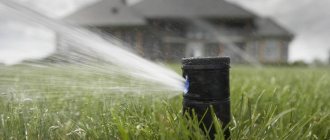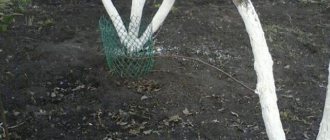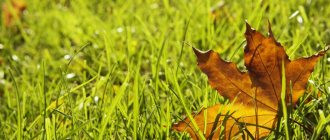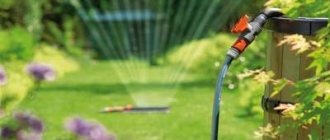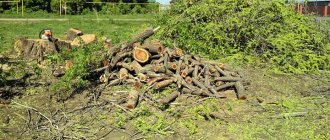Lawn care in the fall and preparation for winter include several simple procedures: timely mowing, aeration and fertilization. We’ll talk more about what else is important to know about pre-winter “lawn” work in our article.
A well-groomed and healthy lawn is a decoration for a suburban area. In order not to think about how to restore a frozen lawn at the beginning of the next season, take care of your garden lawn now. We tell you how to care for your lawn in the fall in order to properly prepare it for winter.
Watering the lawn in autumn
As a rule, autumn comes to our latitudes with its constant companion - rainy weather. During September, the soil receives enough moisture, and therefore the lawn should be watered in the fall only during drought (once every 5-7 days). The sprinkling method is an excellent option, but under no circumstances should you allow puddles to form on the lawn, because... this can lead to rotting.
Typically, watering the lawn is stopped in October so that the soil does not become waterlogged and the grass does not weaken and become sick before the onset of cold weather.
How to prepare for frost and winter?
Before frost, stop watering your lawn. It can only be left in cases where the weather has been sunny and dry for a long time. If early frosts are planned, it is better to remove it altogether. Before frost, cutting and other types of work should be carried out. Also, in preparation for frost, it is necessary to remove weeds, which will spoil the appearance of the site and draw out the necessary nutrients from the soil.
Attention ! It is especially important to remove weeds from a young annual lawn.
When getting rid of weeds before winter frosts, it is important not to use chemical methods. This may damage the grass. Many perennial grasses are best removed after a good watering. You need to pull them out by the roots. This will cause minimal damage to the lawn.
When to mow the lawn in the fall?
If in the summer the dacha lawn is mowed approximately 1-2 times a week, then in the fall this procedure is carried out less frequently. The number of haircuts is reduced gradually as the soil temperature drops and the plants slow down their growth.
You shouldn’t completely give up mowing your lawn in the fall, since grass that is too tall will fall down with the arrival of frost and thereby interfere with the growth of new shoots. The optimal grass height before wintering is 6-8 cm.
The question of when to mow the lawn for the last time in the fall can be answered this way: if you know from the weather forecast when frost will come, do pre-winter mowing 2 weeks before that time. For the middle zone this is the beginning of October, for the south - mid-late October, and in the northern regions the final mowing of the lawn before winter is carried out at the end of September.
How to care when frost occurs?
During the winter season, the lawn becomes softer and more vulnerable. That is why, when frost occurs until the grass is covered with snow at least 15–20 cm, you cannot walk on it. If an ice crust has formed on the site after the winter thaw, it must be broken to provide more air access to the plants.
After cleaning the paths, do not allow snow to fall onto the lawn . If there are no other options, with the arrival of heat it is necessary to free the grass from deposits as quickly as possible. If this is not done, bald spots may appear in these places. They will ruin the appearance of the lawn, which will have to be further repaired.
Fertilizing the lawn in the fall
The first thing you need to remember when choosing fall fertilizer for your lawn is no nitrogen! This element helps accelerate the growth of green mass, and this is not at all what the plant needs to prepare for frost.
For safe wintering of a plant, the main thing is to strengthen its root system, and not the above-ground part, so fertilizer for the lawn in the fall should contain phosphorus and potassium.
7-10 days before the expected frost, fertilize the lawn with bone meal, adding 2-3 cups per 1 sq.m. This will reduce the acidity and will also gradually replenish the soil with nutrients, so that the grass will begin to grow quite early in the spring. Fertilizing the lawn with double superphosphate is effective; application rate: 50-70 g per 1 sq.m.
Potassium will increase the grass's resistance to diseases and give it strength. Suitable for autumn feeding:
- potassium sulfate, or potassium sulfate (20-30 g per 1 sq.m);
- potassium magnesia (30-60 g per 1 sq.m);
- potassium salt (30-40 g per 1 sq.m.), etc.
In stores you can buy fertilizers specially designed for winter application; they are usually called autumn fertilizers. If dry weather persists, water the lawn and allow the grass to dry out before applying fertilizer. After 2 days, water again if there was no rain during this period.
What tools and equipment will be required?
There is a large selection of tools and special equipment that can be used to care for your lawn. They can be divided into several groups:
- Manual or mechanical aerators . They are made in the form of devices consisting of rotating disks with peculiar knives. With their help, you can make depressions up to 6 cm in the soil with a lawn. Such devices are convenient to use. They are compact in size and do not require complex care or maintenance.
- Battery aerators . They have the same principle of operation, but are more functional. Powered by a portable charger.
- Verticutters, electric aerators and rakes . They work from the network, thanks to the plague you can ensure uninterrupted operation. Convenient when caring for a large area with a lawn.
- Gasoline verticutters and scarifiers . They can work autonomously without the need to connect to the network.
In addition to the basic tools, there are other devices with various attachments, knives and needles. All of them are necessary to ensure proper ventilation of the root system, and also saturate the lawn with moisture and help treat areas with bald spots. With their help, you can organize faster growth of new grass.
Lawn aeration in autumn
To saturate the soil with oxygen, it is necessary to aerate the lawn, and autumn is no exception. If you don't have an aerator, take a regular garden fork and, while pricking the soil, slightly lift the layer of turf, tilting it slightly towards you. It is best to do this in dry weather.
Some useful tips on how to properly pierce turf with a pitchfork:
- Make punctures at a distance of 20-30 cm from each other.
- A suitable puncture depth is 15-20 cm. This will allow moisture to penetrate into the deep layers of the soil and prevent the formation of an ice crust on the surface of the lawn.
- After the procedure, give the lawn a rest - do not walk on it for 2-3 days.
There are two opposing opinions about whether to remove leaves from the lawn in the fall. Some say that leaf fall is natural in nature, which means that the leaves can be left untouched throughout the entire area. But this approach is too categorical: a lawn is an artificially created landscape, so the “naturalness” rule does not work with it. If leaves are left on the lawn, they will be compressed under a layer of snow, which will prevent the grass from growing properly.
What else can be done to improve the coverage?
In addition to the basic activities, there are other important points that need to be taken into account when caring for your lawn. These primarily include leveling and changing shape, which may be required in some cases.
Alignment
The lawn leveling procedure is necessary if unevenness appears on it. It is necessary to level them in the fall, but sowing the seeds can be done in the spring. The following technology should be followed :
- If there are small depressions, a mixture of sand and leaf humus in a 1:1 ratio should be poured on top of the grass. After this, the selected area should be compacted.
- If a bump has formed on a lawn area, you need to carefully trim the turf, then bend it back and remove excess soil. Then you should level the area and return the turf layer with the lawn to its place.
- If a deep pothole appears on the grass, you need to prepare a special mixture consisting of earth, sand and humus. After this, you need to remove the turf layer in the area of the recess. The prepared soil mixture can be poured into the pothole. The area needs to be compacted and watered well so that the soil settles. New lawn seedlings should be planted on it. This can be done in the spring.
Changing shape
If you want to change the shape of your lawn, you can also do this in the fall.
This can be done by simply modifying the existing grass cover rather than planting new grass. To do this, you need to analyze the condition of your lawn. If it is in bad shape, you need to dig it up and replant individual areas. If the grass is not in bad condition, the lawn will be easier to repair.
To change the shape, you need to cut out the turf in unnecessary areas and carefully move it to another place. If you want to give your lawn an irregular shape, you can mark it out using rope, pegs and a flexible hose. You can give your garden a more informal look by using curved edges. For this it is worth using special plants.
What happens to the lawn in winter?
Under a layer of snow, lawn grass overwinters in fairly comfortable conditions if it is properly prepared for this. Beginning lawn owners sometimes leave a very grown lawn, above 10 cm, in the winter, hoping that the long grass will save the roots from freezing. In fact, it is better to trim the lawn before wintering.
A stable snow cover will warm the grass much better than a layer of mowed grass. Under a blanket of snow, very tall lawn grass will rot, and in the spring, old compacted grass will prevent young shoots from breaking through to the light. A young lawn will emerge much slower.
“A large number of microorganisms settle on withered grass in the fall, which can cause outbreaks of infection. Therefore, it is very important to send a neatly trimmed lawn (grass height 5–10 cm) under the snow.”
MOST READ FROM PARTNERS
Mown grass, twigs and leaves should be removed from the lawn before winter, and heavy objects should not be left on it that should not be there. By doing simple manipulations and devoting a little time to the lawn, you will see that later it will bear beneficial fruits. This is not only an aesthetic event, but also a prevention of fungal and infectious diseases of your lawn. If the lawn cover extends to a great height under the snow, then rodents can make burrows in such grass under the snow. They will destroy the integrity of the turf and can also be carriers of fungal diseases.
- Do not forget that in winter, under a layer of snow, the lawn breathes. Therefore, if during a thaw a hard ice crust has formed on the snow surface, you need to carefully break it, loosen the snow so that the grass “breathes” and does not rot without oxygen.
- When clearing paths of snow, do not throw snow blocks onto your lawn; try to remove the snow beyond the perimeter of the lawn. The snow should lie flat on the lawn; a thickness of 15-20 cm is enough for your green friend to overwinter without hardship.
- Another important point that cannot be ignored. Try not to lay winter paths on the lawn, do not arrange New Year's fireworks, skating rinks and slides for children on it. Do not place a Christmas tree on your lawn. Otherwise, the lawn will simply die.
“With the onset of spring, the snow begins to melt very unevenly, level the snow cover so that your lawn does not turn green in parts.”The lawn under the snow is very sensitive to trampling. If you need to walk on the lawn in winter, you need to place wide boards under your feet. This will protect the grass from dying.
Winter lawn care tips
In this section we have collected useful recommendations from experienced gardeners and landscape designers. Our advice will help you get answers to all frequently asked questions - when to apply fertilizer for lawn grass, how to carry out vegetation care procedures, what to do to protect your lawn from diseases and pests.
- To prevent stains and bald spots from appearing on the site, you should not throw snow from the paths onto the lawn. Long melting of snow in the spring can significantly deteriorate the appearance of your coating.
- When should you apply complex autumn fertilizer? We recommend fertilizing the soil only after all necessary procedures have been carried out. It is better if the fertilizer is in solid granular form.
- Winter grass varieties will help speed up spring growth. If you want luxurious greenery as quickly as possible, plant some bluegrass or ryegrass. These varieties ripen the fastest.
Autumn sowing of lawn grass
It happens that I do not have time to prepare a place for sowing lawn grass in the spring. In this case, I sow it in the fall, in the second half of September, when the air is already sufficiently humidified and there is no threat of drought. But sometimes, if the weather permits, I sow the lawn in November.
Autumn sowing of the lawn.
If you sow grass in September, then its root system will have time to form and strengthen, and the grass will go to winter, having grown to the desired height. November sowing also has its advantages - light frost, which is no longer uncommon this month, will harden the young grass, thanks to which it will acquire increased frost resistance. During its November sowing, I increase the consumption of seed material to 50% of the usual rate.
I begin to prepare the soil for the lawn in advance: a few weeks before sowing, I dig it up, removing debris, stones and weeds, after which I level and compact it. Seven days before sowing day, I add a special mineral fertilizer intended for lawns, which I buy at the store, into the soil. I scatter the seeds in a fan manner, then embed them in the ground with a rake. Then I sprinkle the sown area a little with peat and water it.
Sowing.
One of my lawns is located in a low area. It needs good drainage. To arrange it, I removed a thick layer of turf from the area allocated for the lawn, obtaining a kind of shallow pit, evenly scattered gravel mixed with broken bricks along its bottom and covered everything with coarse river sand with a cushion 10 cm thick. Then I laid a layer of fertile soil on top and leveled it it with the help of a massive log, after which he sowed grass. As a result, the lawn turned out great - excess moisture does not accumulate in the ground, the grass looks healthy, grows evenly and is pleasing to the eye for several seasons now.
Advantages and disadvantages of winter sowing
Late autumn planting has many benefits, here are some of them:
- the soil and air have the necessary humidity;
- saving time and effort;
- the lawn becomes frost-resistant;
- during this period there are practically no weeds;
- after winter, the seeds begin to grow actively and evenly;
- plants are not exposed to pests and diseases characteristic of this crop.
The disadvantages include the following factors:
- Not everywhere you can plant lawn grass. Areas where there are slopes are not intended for this vegetation, since with heavy rain or melting snow, the seeds will float along with the soil.
- If you plant grass later or earlier than the specified time, there is a chance that the seeds will freeze and will not survive the winter. However, if you follow all the recommendations and correctly calculate the time period, there will be no such problems.
As you can see, there are many more advantages than disadvantages. Now you need to decide on the type of lawn and find out what is required to plant it.
Process
Since after planting the seed material needs water vitally for development and growth, the autumn watering of seeds and an adult lawn will be different. The sown seeds are watered more often. In the absence of rain (if it is a September sowing) during the first ten days - daily or every 1-2 days.
A mature lawn is watered less often in the fall, but the amount of water, compared to watering seeds, is much greater. Here you need to “water” the plants and root system.
How to moisturize manually?
Watering your lawn yourself is simple:
- the settled water is poured into watering cans;
- thoroughly water the lawn around the entire perimeter;
- the soil should be 8-12 cm moist.
It is advisable to use hoses with a “soft” water supply , this will speed up the work.
Using an automatic system
Various alternative options greatly simplify the watering process for the gardener:
- the automatic system (high cost) turns on and off independently - it will not forget about watering the lawn, and is indispensable for very busy people, the best option for country mansions;
- sprinklers are in demand among summer residents - the design directs streams of water in a circle, and you can independently adjust the diameter to water the area;
- hoses with perforations throughout the body represent the simplest design (an excellent budget option) - they are distributed along the perimeter of the lawn;
- circular sprinklers - suitable for small lawns and have a minimal cost.
It should be remembered that often when using an automatic irrigation system, “blind zones” may appear where irrigation either does not flow at all, or a minimal amount of moisture enters. They need to be watered by hand.
Errors
When moisturizing in the autumn, you can make the following mistakes::
- Watering in small volumes, but often - the surface of the earth is moistened, and the inner soil is dry. The root system will be forced to be close to the surface. This will deprive the plants of the ability to absorb nutrients from the depths. From such a shortage, the lawn grass can dry out and turn yellow. The error is corrected by sufficient, abundant irrigation (regular).
- Watering in excessive amounts - puddles appear on the lawn, the water literally “stands” on the site. It is recommended to provide up to 20-40 liters of water for every 1 m2 in summer. With the onset of autumn and taking into account temperature, precipitation and climate zone, this norm is adjusted “to suit you”. Excessive moisture is unacceptable for lawn grass.
- Irrigation with ice water will cause obvious harm to the root system; the lawn may become sick, dry out, turn yellow, or die. Only water with a temperature of at least +10°C should be used.
- Wrong time for watering (day or late evening). In the first case, on a sunny day, the grass may get burned, unless it is a cloudy day (then watering is possible). In the second case, the grass will not have time to dry out, the nights are cold in the fall, this will lead to stagnation of water, rotting, and the development of pathogenic microbes. You should water the lawn early in the morning both in summer and autumn - the soil will have time to evenly absorb moisture, and the grass will dry before the sun appears.
The most serious mistake is watering the lawn in late autumn, when the water in the soil can turn into ice and the lawn will freeze. The autumn watering season should be completed on time.
Lawn care after winter
The lawn requires no less attention after winter. With the arrival of stable warmth, it is necessary to feed the soil even before the young grass grows. The fertilizer complex, in addition to phosphorus and potassium components, must contain nitrogen, which promotes better plant growth. Fertilize in the evening and water the lawn generously until the fertilizer is completely dissolved.
After 1.5-2 weeks it is necessary to “comb out” the lawn. This procedure will provide air access to the root system of the plants. The resulting felt, if not combed out, can lead to grass disease.
In spring, as well as in autumn, it is necessary to aerate the lawn . This can only be done in places where water stagnates, in lower areas.
With the arrival of warmer weather, weeds begin to actively grow on moist soil. The fight against them in small areas of the lawn can be done mechanically or manually. But if the lawn area is large, then a chemical method of weed control comes to the rescue - the application of selective herbicides that will destroy weeds without damaging the lawn.
MOST READ FROM PARTNERS
In the spring, it is necessary to restore the lawn by sowing seeds on bare areas. The sown area must be compacted and watered.
By following these simple rules, you can not only protect your lawn from winter cold, but also provide it with proper nutrition and active growth in the spring.
ACTUAL NEWS
You may also find the following materials useful:
- Cotoneaster brilliant: photo and description of the shrub, planting and care, hedge
Autumn mulching and sanding for the lawn
After cutting and scarification in early autumn, the lawn can be mulched, evenly distributing loose and fertile substrate over the surface. It will protect against moisture evaporation and optimize soil permeability, level out any unevenness that has arisen over the current year, and contribute to thickening of the grass stand. Typically, the lawn is mulched with a complex subtart (sand, turf soil, peat in approximately equal parts), adjusting the amount of sand for heavy or sandy soils.
In lowlands or with heavy soil, problems with damping off or bald spots, mulching can be replaced or combined with sanding, which can also be carried out until mid-September.
In September, lawns are fed with special autumn fertilizer.
